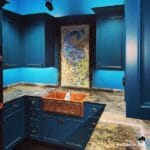If you’ve been exploring countertop designs, you have probably noticed that the edge you choose can completely change the mood of your kitchen or bathroom. A straight cut feels sleek and modern while a rounded edge comes across as soft and family friendly. Then there’s the ogee edge countertop style that instantly adds elegance almost like putting a frame on a beautiful painting.
This design has been around for centuries used in furniture, architecture and decorative moldings. When brought into countertops it gives the surface a graceful curve that feels refined without being over the top. Let’s break down what makes ogee edge countertops special, where it work best, and what you need to consider before choosing one.
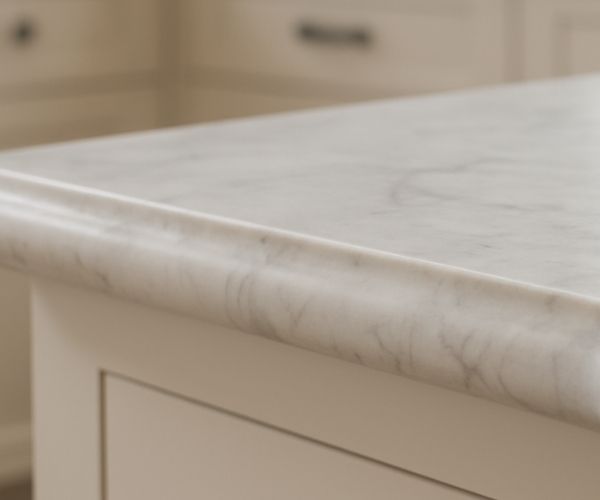
What Exactly is an Ogee Edge?
Picture the letter “S” stretched on its side—that’s the shape of an ogee edge. The design starts with a small inward curve that rolls outward into a soft arch. It’s delicate, but noticeable enough to stand apart from plain, straight-cut edges.
The beauty of this profile is in the detail, on a slab of marble or granite it catches the light in different ways and highlighting the natural veining of the stone. It’s not just functional it’s decorative, like jewelry for your countertop.
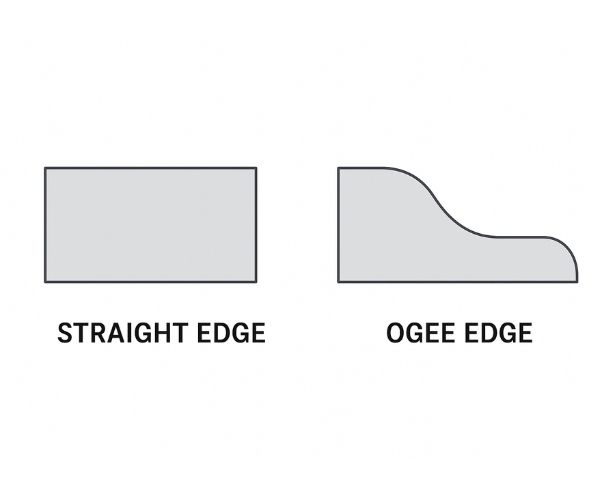
Why People Love Ogee Edges
One of the biggest reasons homeowners choose this edge is the instant touch of luxury it brings. Walk into a kitchen with an ogee-edged island, and you’ll see how it pulls your eyes toward the centerpiece of the room.
But beauty isn’t the only reason:
- Timeless design – Ogee edges don’t chase trends. They’ve looked stylish for hundreds of years, and they’re not going anywhere.
- Custom appeal – Instead of a “builder-basic” look, it makes the countertop feel custom-crafted.
- Flexible styling – While it leans traditional, it also works well in transitional spaces that mix old and new.
For homeowners who want a little extra charm without going overly ornate, the ogee edge strikes the perfect balance.
See More: Waterfall Edge Countertop
Best Materials for Ogee Edge Countertop
Not every material can pull off this detailed cut. Ogee edge needs strength to hold its shape so dense materials are the go to choice.
Granite – It has character and is long lasting looks particularly good with an ogee profile and the edge draws attention to how its patterns move.
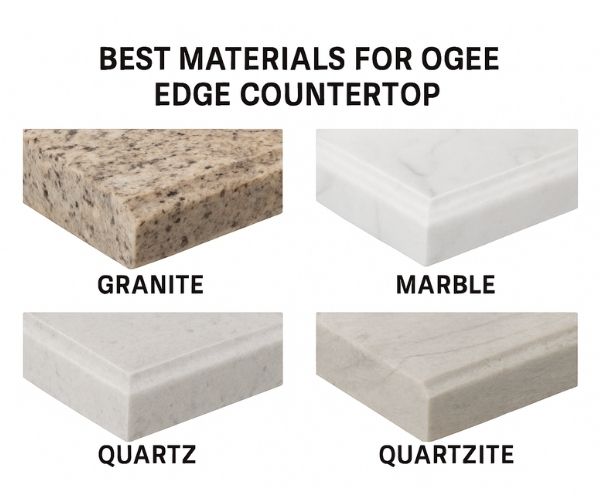
- Marble – Marble’s gentle veining, and a timeless beauty make it a perfect match for the curved detail of the ogee edge.
- Quartz – Engineered quartz has the strength needed for carving and many brands offer ogee as a premium edge option.
- Quartzite – Harder than granite, quartzite makes a bold and lasting statement with an ogee cut.
- Solid surface (like Corian) – Less common, but it can be shaped into an ogee for a more subtle effect.
If you’re working with materials like laminate, the design doesn’t translate as well, so it’s not usually offered.
Design Styles That Suit Ogee Edges
The ogee edge is often linked with traditional kitchens, but it’s versatile enough to work elsewhere.
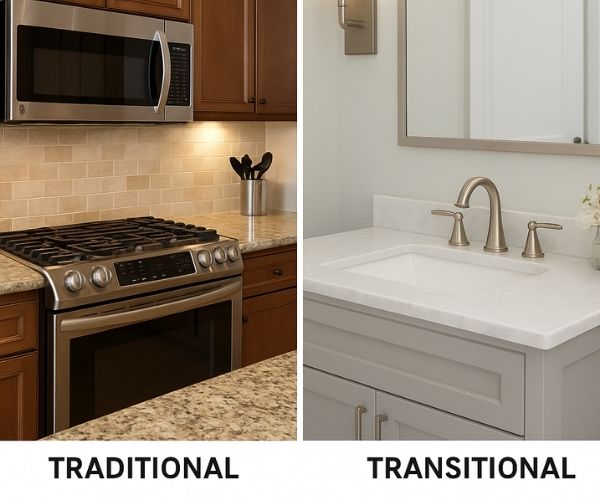
- In a formal kitchen with raised-panel cabinets, the ogee ties everything together.
- On a bathroom vanity, it adds a boutique-hotel feel.
- In a transitional space, it balances modern fixtures with a touch of softness.
- For luxury projects, a double ogee edge makes the countertop look even more like a centerpiece.
That said, if you’re aiming for an ultra-minimalist design, you might prefer a square or beveled edge instead.
Variations of the Ogee Edge
There isn’t just one type of ogee, fabricators often offer a few variations depending on how dramatic you want the profile to look:
- Full Ogee – Deep curves for a bold decorative finish.
- Half Ogee – A softer version easier to clean and less likely to catch crumbs.
- Double Ogee – Two stacked curves for maximum detail often seen in luxury spaces.
Subtle, bold, or extravagant each one changes the countertop personality.
See More: Sparkling White Quartz
What Does It Cost?
Adding an ogee edge is usually considered an upgrade, so it comes with extra cost compared to standard edges.
Most fabricators include simple profiles like eased or beveled in the base price. Ogee, being more detailed, can run an additional $15 to $40 per linear foot, depending on your material and location. Double ogee edges usually cost even more since they require extra labor.
If you’re already investing in high-quality stone, the added price may feel small compared to the overall project—especially if it delivers the upscale look you’re after.
Things to Keep in Mind
As with any design choice, it’s not all about looks. Here are a few practical points about ogee edge countertops:
- Cleaning – Crumbs and dust can settle in the curves so you will need to give the edge a little more attention when wiping down.
- Durability – The thinner parts of the profile can be more vulnerable to chips, if hit with heavy objects.
- Safety – Unlike sharp edges the curved design is smoother to the touch which can be safer for households with kids.
It’s a small trade-off: a little more cleaning effort for a lot more character.
Ogee Edge vs Other Popular Edges
To really see if an ogee is the right fit it helps to compare it with other options:
- Straight/Eased edge – Modern and simple but lacks decorative detail.
- Beveled edge – Clean and angled offering beauty without curves.
- Bullnose – Rounded all the way practical and safe but more casual.
- Waterfall edge – Extends the countertop material down the sides. Sleek and dramatic, but very modern.
Compared to these, ogee sits firmly in the “classic elegance” category.
Where to Use Ogee Edges
Most people think of countertops in the kitchen, but this edge works in other areas too:
- Kitchen islands – Turns the island into a statement piece.
- Bathroom vanities – Add luxury to everyday routine.
- Bar tops – Gives the impression of a high-end entertaining area.
- Fireplace surrounds – Bring architectural detail, into living rooms.
It’s a flexible design element that can elevate any surface where stone or quartz is used.
See More: Cost of Granite Per Square Foot
Tips for Choosing the Right Ogee Edge
If you’re leaning toward this style, here are some quick tips:
- Pair it with detailed cabinetry – Shaker or raised-panel cabinets look great with ogee.
- Go thicker – A 3 cm slab shows off the curve more than a thinner one.
- Think about cleaning – If you want low-maintenance, consider the half ogee instead of the full or double.
- Request samples – Edges look different depending on lighting and stone patterns. Always see a sample before finalizing.
Balance your budget – Factor in the upgrade cost so, there are no surprises later.
Wrapping It Up
This odge edge countertop is a design element that can turn a surface into a focal point and is more than just a finish. Whether on quartz, granite, or marble, it exudes elegance, craftsmanship, and history.
Yes, it may cost a little more and need a touch more care, but the payoff is a countertop that feels timeless and personal. For anyone looking to create a space with character and sophistication then the ogee edge is a choice that rarely disappoints.

